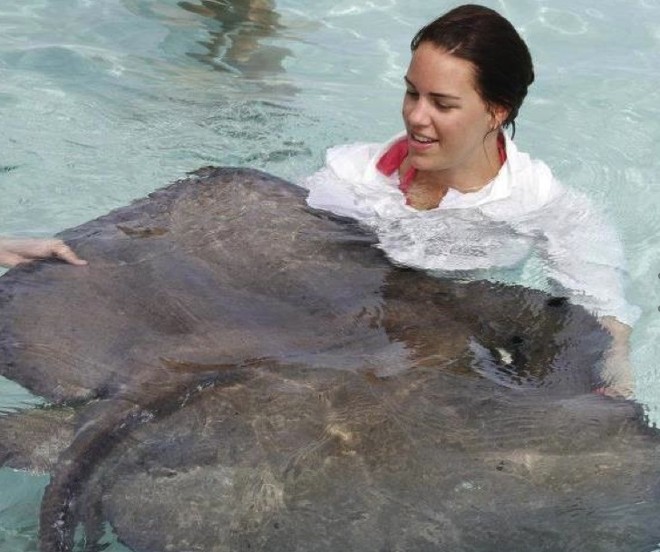Annual Cayman Stingray Census shows general improvements
by Guy Harvey PhD. on 16 Jul 2013

Stingray Study in Cayman Islands John Bell
The 2013 census of the North Sound stingray population was just completed this past week and the news is generally good. On day two of the census, I had a late start as I was able to meet with the new Chief Officer in the Ministry of the Environment Dr. Dax Basdeo and MLA Roy McTaggart in the Government administration building. I was able to update the CO about the socio economic value of the stingrays to the country and the status of the ray population.
This animal has appeared in every single media advertisement, printed and electronic, every documentary or tourist guide ever done about the Cayman Islands for the last thirty years. It is now on the new $50 note! Until May 17, 2013 this extremely valuable animal was not even protected outside the Wildlife Interactive Zone. In spite of that protection four animals ended up at Dolphin Discovery sometime in early 2012. No one could tell me how they got there! Because they had been tagged by the Guy Harvey Research Institute (GHRI) in the January 2012 census the evidence was clear that they had been taken from the sandbar confirming my theory that the decline in the number of stingrays over the last two years was partially due to sabotage.
My conservative estimates assuming 400,000 people visiting the sand bar each year paying $40 per head put the value of each ray at $500,000 per annum. They are slow growing, long lived animals and so in 20 years (and many of the large females are 30 plus) they can generate for this country between $10,000,000- $15,000,000….each! The major push to protect these animals was begun in July 2012 and was finally gazetted in mid May 2013. There being no other user group (commercial fishing for example) the rays are not endangered, but because of their celebrity status they have finally earned that protection. It is time the numbers of visitors to the sandbar be counted so we know exactly what the stingrays bring in revenue for this country.
It was amazing to me that for the 12 years I have been leading the census that protection was limited to not lifting the rays out of the water (as many tour operators used to do…the stingray sombrero). The handling of rays by tour operators has improved because of guidelines drawn up by the Department of Environment (DoE). But the tour operators do very little else to guard the goose. They show up every day expecting the rays to be there. Hey you tour operators…how about forming a group to work with the DoE and have eyes watching the sandbar 'after hours'. You all need to butch up and assist the understaffed, underfunded DoE and do your part. It would be great to see you take the initiative.
The old law did not contemplate theft of the rays from the sandbar. There are also unverified reports of rays being caught and consumed. Up to May 2013 anyone could catch a ray outside the WIZ and keep it in their bath tub or even (it has been said) taken out of the country by boat. In fact in the late 1980s there was an attempt to take 10 adult females to Cayman Brac to start the ray experience there.
The 2013 census ran for five days and was conducted by three vets from the Georgia Aquarium in Atlanta, the director of the GHRI Dr. Mahmood Shivji and by Dr. Brad Wetherbee an elasmobranch specialist from the University of Rhode Island as well as DoE staff who have been part of the census from the start. We are ably assisted for three days by Island Vet’s Dr. Ioana Popescu and several other volunteers.
In all 75 rays were sampled at the sandbar, up from an all time low of 57 in July 2012 which was four less than found in census of January 2012. Why was this census done in January? In spite of no counts since July 2008 observations indicated a reduction in the numbers of rays. The number has been been fairly stable for the last 20 years, so what was causing this reduction?
In addition to the usual measurements, DNA samples and blood being taken, the GA vets brought an ultrasound computer with which they were able to detect pregnancy, even in the very early stages which you cannot see by just looking at the female ray. Once they begin to 'show' there is a bump toward the back end of their disc. About 20% of the females sampled were pregnant. This is good. The site needs the new animals to replace those that leave, are caught accidentally or are eaten by their natural predators like tiger sharks or hammerhead sharks. These great predators are few and far between nowadays and were not considered by the scientists as the cause for the sudden decline in numbers in 2011 and 2012.
The added horsepower provided by the GA vets health assessment is invaluable. This is the basis for a good long-term assessment on these animals. The vets said last year that the squid fed to the rays is not the best food in terms of nutrition and there needs to be more fish added to their diet. An inexpensive way of acquiring this fish is to collect the fish cuttings and scraps from restaurants that do not already feed tarpon at night to the delight of their clients. These cuttings would be great for the rays. In addition lionfish carcasses (spines removed) are slurped by the bigger rays.
Who is going to organize such a collection system with the help of the restaurants? Recycled fish also means less smelly trash on the dump.
There were a dozen newly tagged rays counted in the census so recruitment of new animals is taking place. Also several were processed that were already tagged but were not sampled in the 2012 census. This indicates that some rays will spend more than three days away from the sandbar at any time. The census is only three days long so if it is not at the sandbar over that period the ray will not be counted.
I almost forgot to mention the stings. Last year I made the decision on the spot to clip the tips off the stingray stings as a safety precaution. We were working in close quarters with big powerful animals that had the means to injure one of the vets badly. The DoE and marine Conservation Board were understandably concerned, particularly as I had not requested permission to do this. I knew from previous experience that the stings grow back. Indeed the vets said they routinely clip the stings of the rays in the aquarium’s touch tanks as they grow back. During this census we found that most of the stings were generating new points and some were growing a new sting below the older clipped sting.
In addition 15% of the rays have had their stings completely cut out by other people. The bed of the sting is removed (like your nail bed) so the sting does not grow back. No stings were clipped during this census.
We await the health assessment from the Georgia Aquarium vets and will keep all informed as to the recommendations. Meanwhile the remaining six captive rays at Dolphin Discovery were released at the sandbar on Friday July 14 by the DoE. All were tagged. It is great to have those five adult males back in the mix to keep our stingray population more balanced and healthy. It is good for everyone.
It is our collective responsibility to conserve the marine environment and maintain the biodiversity of the planet.
Fish responsibly, dive safely.
If you want to link to this article then please use this URL: www.sail-world.com/111995

